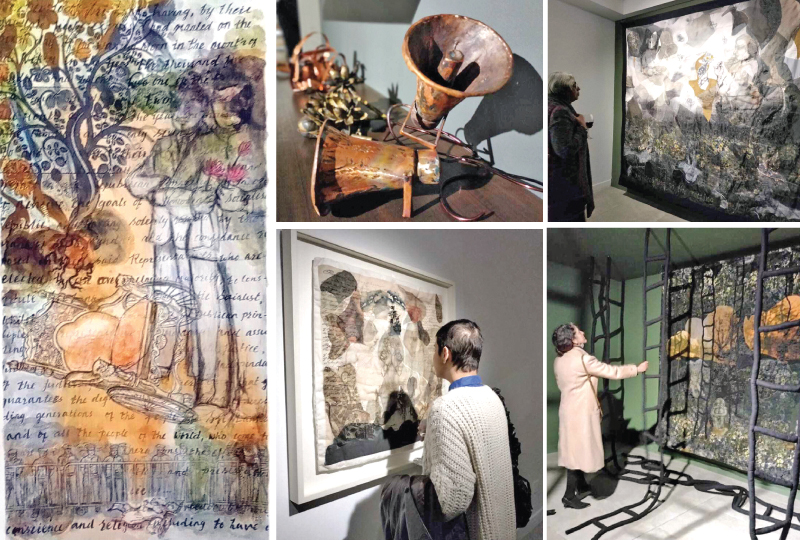Anoli Perera’s latest solo exhibition, ‘Debris Collector’ which got underway at New Delhi’s Shrine Empire Gallery on January 30, in parallel to the India Art Fair 2024, concluded on March 2.
Containing about 13 artworks consisting of two main installations, paintings on paper, cloth tapestries and cluster of small brass sculptures presented together as ‘objects of interest’, it is a powerful and bold commentary on the socio-political and economic situation in Sri Lanka. Perera’s art is one of the most obvious practices in South Asia which has creatively and self-consciously bridged the gap between the ‘personal’ and the ‘political’ and the ‘local’ and the ‘global.’
She often exposes the meaning of the ‘political’ in its plurality, while bringing in aspects of her own personal life and weaving it to the larger issues that haunts South Asia in general – autocratic regimes with flawed paradigms of development and freedom which have been failing its citizens.
As Perera notes in her concept note for the exhibition, “the nature of debris is defined by the person who collects it, and its stories are woven into tapestries we call ‘history(ies)’”and “lands are harvested and drained, self-destructively and periodically, leaving only the residual artefacts of once glorious and inglorious histories as mementos. Citizenry are led, fractured and rehashed in haste, to a promised new beginning built on yesterday’s debris.
Curatorial advisor to the exhibition, Nancy Adajania said that the ‘Debris Collector’, makes us “experience the stench of a present that is held hostage by the past, and condemned to a future that is always imminent, just out of reach.” She aptly adds that “the artist tries to make sense of the endless cycles of violence and images on fabric. A palimpsest approach, as opaque as it is transparent, of veiled beginnings and endings with the middle having fallen through.”
Not simply in ‘Debris Collector,’ but in general, Perera’s art has perpetually challenged the fuzzy boundaries between what is popularly known as ‘craft’ and ‘art’ or ‘high art’ and ‘low art.’ She is one of those rare visual artists from the region who has been subversive in her approach to art both in terms of materiality and process as well as thematics. In her current work, Perera’s engagement with aspects of memory, nostalgia and history takes form in an interplay of light and shadows.
Historical narratives
In a sense, it is a ‘dark’ where selective lighting dramatises and emphasises both the art’s forms as well as their meanings. Walking through the exhibition, one is confronted with two equally crucial and provocative questions: ‘what is left behind?’ and ‘who are collecting the left-over debris?’ She weaves the complex historical narratives that emanates from these questions into tapestries, a highly labour-intensive process bringing myriad of materials and techniques and other visual expressions that vary from embroidery and printed images on fabric to crochet panels, a video and finally printed and worked upon prints on paper.
Perera’s artistic trajectory aptly demonstrates her aesthetic and political sensibilities, which are inscribed on her artworks. To the viewer, they are stunning at the first glance, but on a closer look, would equally as easily puts her/him in a state of unease. Two such examples from ‘Debris Collector’ are its main installations, ‘Conquest’(single channel video, crochet lace panels and saltwater pool; size variable; 2018) and the ‘I am Drowning Series II’ (acrylic and charcoal pencil, printed image overlays on fabric with stitching; size: 84 x 96 inches; 2023). My reading in this review is based on these two installations.
The Conquest, with its crocheted lace panels and a black and white video takes the viewer through the narrow lanes of Galle Fort with its colonial past represented by the fort itself and the crochet, a colonial legacy and its postcolonial present where the fort has become a tourist attraction with boutiques, cafes, jewellery and gift shops within it. The installation description states that the crochet lacemaking has “evolved from being a pastime for upper class women during the colonial era to an exotic and elusive item sold for high value now along the maritime coastal areas”.
The video, in loop, concludes with a man jumping from the top of the fortress into the ocean beneath for a promised fee. An ironic and dangerous exercise, he resurfaces from the rocky sea down below after the jump with a sense of triumph. What are the debris he is collecting from the phases of history that Sri Lanka has gone through as well as his personal life? One wonders about the extreme to which ordinary citizens are pushed for mere survival since the colonial era and Sri Lanka’s post-colonial existence and through three decades of civil war and the bouts of political violence and more recent miseries from economic calamities that have stripped off the country.
Treacherous paths
On a similar tangent, ‘I am Drowning Series II’ highlights that “the debris of yesterday become a comfort zone for some today, but a nightmare for others where residues of its memorialisation refuse to leave the consciousness, haunting every moment.” One is then doomed to be encircled by the same loop of sordid memories and decaying hope. The black ladders attached to the large tapestry are symbolic of the treacherous paths people are taking to escape the county’s economic and social difficulties of the present. Anoli Perera once again calls our attention to the domain of visual art that could and should be treated as a legitimate repository of history and contemporary socio-political realities.
Curatorial advisor, Nancy Adajania sums up well what the exhibition is all about: “In the exhibition space, we walk precariously between a man poised to jump off the edge of danger and an angel’s wings made true by a welder’s torch. We pass through landscapes displaying screaming children and trees burnt a fiery orange. We hope for redemption when we come across ladders thrown from the sky like SOS signals. But we know that a ladder like this is no trapeze. Whether the denizens of Perera’s tapestries climb up or down, they will always be imprisoned in an Escheresque game of no return.”
In short, “Debris Collector’ is about bringing to the fore the anxieties of living in uncertain times and a calamitous past where at best the future is unclear.
Dr. Pooja Kalita is a Research Fellow with the Heritage as Placemaking Project at South Asian University, New Delhi.





